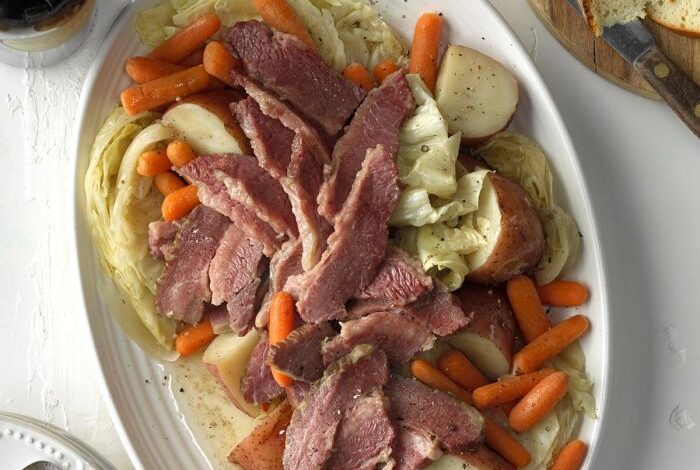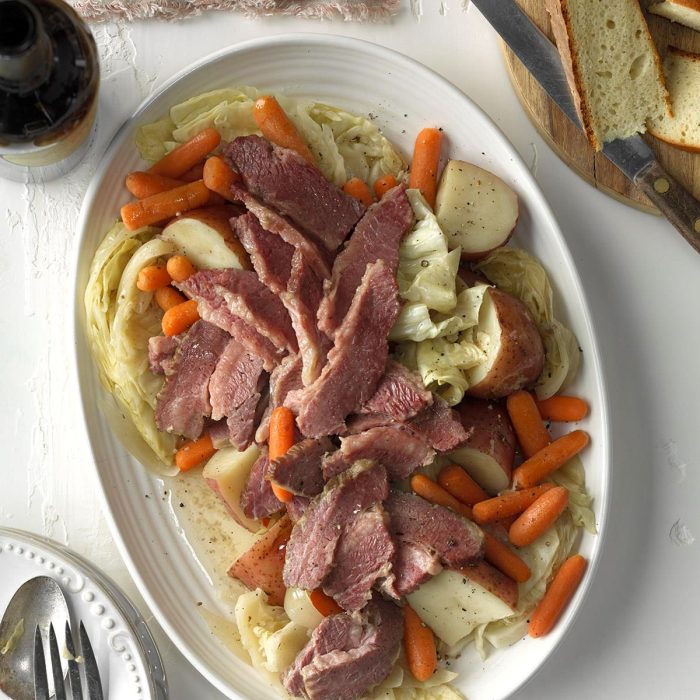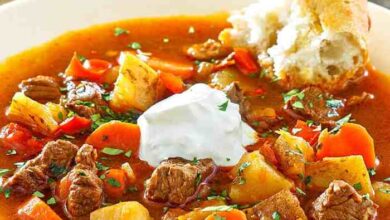
Corned Beef and Cabbage II: A Deeper Dive
Corned Beef and Cabbage II: A Deeper Dive takes you beyond the basic recipe, exploring the rich history, cultural significance, and modern interpretations of this classic dish. We’ll uncover the origins of this iconic meal, delving into its evolution from humble beginnings to its place on modern tables.
Get ready to discover the fascinating stories and traditions surrounding this beloved comfort food, and learn how to elevate your corned beef and cabbage game with innovative techniques and exciting flavor combinations.
This post will guide you through the process of corning beef, highlighting the different cuts of beef and their unique characteristics. We’ll also provide a step-by-step guide to preparing this dish, including cooking methods and tips for achieving optimal flavor.
From regional variations and culinary pairings to nutritional value and health considerations, we’ll cover all aspects of this enduring culinary tradition.
History of Corned Beef and Cabbage
Corned beef and cabbage, a classic comfort food, has a rich history intertwined with cultural and economic factors. Its origins can be traced back to the 18th century, evolving from a humble dish consumed by working-class immigrants to a beloved culinary tradition in the United States.
Origins and Cultural Significance
The origins of corned beef and cabbage can be traced back to Ireland, where salt-cured beef was a staple food for centuries. The term “corned” refers to the process of preserving meat with coarse salt, known as “corns” of salt.
The combination of corned beef and cabbage emerged in the 19th century, driven by Irish immigrants seeking affordable and familiar food in their new homeland.
- The Irish potato famine (1845-1852) played a significant role in the popularity of corned beef and cabbage. The famine led to mass emigration from Ireland to the United States, where Irish immigrants brought their culinary traditions with them.
- Corned beef was readily available and affordable in the United States, particularly in large cities with significant Irish populations. It became a symbol of Irish identity and a reminder of their heritage.
- Cabbage, a versatile and inexpensive vegetable, complemented the rich flavor of corned beef. The combination provided a hearty and satisfying meal for working-class families.
Evolution and Modern Variations
Over time, corned beef and cabbage evolved into a quintessential American dish, incorporating local ingredients and regional variations.
- The dish has become a popular tradition for St. Patrick’s Day celebrations, symbolizing Irish heritage and cultural pride.
- Modern variations of corned beef and cabbage have emerged, incorporating ingredients such as potatoes, carrots, and turnips.
- Some restaurants and home cooks experiment with different cooking methods, such as slow-cooking or braising, to enhance the flavor and tenderness of the corned beef.
Ingredients and Preparation
Corned beef and cabbage is a hearty and flavorful dish that has been a staple in many cultures for centuries. The process of corning beef and the ingredients used are key to creating a delicious and satisfying meal.
The Process of Corning Beef
The process of corning beef involves preserving a cut of beef using salt, curing it and giving it a distinctive flavor. This traditional method of preserving meat has been practiced for centuries, allowing people to enjoy beef throughout the year.
The corning process involves immersing the beef in a brine solution containing salt, sugar, and various spices. The salt draws out moisture from the beef, inhibiting bacterial growth and preserving the meat. The sugar adds sweetness and depth of flavor, while spices like black peppercorns, bay leaves, and juniper berries enhance the overall taste profile.
- Brine Solution: The brine solution is the heart of the corning process. The typical ratio of salt to water is about 1:4, but the exact proportions can vary depending on the desired level of saltiness and the length of the curing process.
Sugar is typically added at a ratio of about 1:10 with salt. Spices are added according to taste preference, but common additions include black peppercorns, bay leaves, juniper berries, and coriander seeds.
- Curing Time: The length of time the beef is cured in the brine solution depends on the desired level of saltiness and tenderness. A typical corning time is 7-10 days, but some recipes may call for longer curing times, up to 2-3 weeks.
The longer the curing time, the saltier and more flavorful the corned beef will become.
Cuts of Beef Used for Corned Beef
The most common cut of beef used for corning is the brisket. Brisket is a tough cut of meat, but it becomes tender and flavorful after being corned. It is typically cut into two sections: the flat and the point.
- Brisket Flat: The brisket flat is a leaner cut of meat, with less marbling than the point. It is ideal for corning because it cooks evenly and develops a nice crust when roasted.
- Brisket Point: The brisket point is a more fatty cut of meat, with more marbling than the flat. It is also suitable for corning, and it becomes incredibly tender and flavorful after cooking. The point is typically preferred for making corned beef, as it has a higher fat content, which contributes to a more flavorful and juicy final product.
Preparing Corned Beef and Cabbage
Once the corned beef has been cured, it is ready to be cooked. There are several methods for cooking corned beef, but the most common is to simmer it in water or broth. Here is a step-by-step guide for preparing corned beef and cabbage:
Step 1: Rinse the Corned Beef
Rinse the corned beef under cold water to remove any excess salt.
Step 2: Place the Corned Beef in a Large Pot
Place the corned beef in a large pot or Dutch oven.
Step 3: Add Water or Broth
Add enough water or broth to cover the corned beef by about 2 inches.
Step 4: Add Vegetables
Add vegetables such as carrots, onions, and celery to the pot. These vegetables will add flavor and color to the broth.
Step 5: Simmer the Corned Beef
Bring the pot to a boil, then reduce the heat to low and simmer the corned beef for 3-4 hours, or until it is tender.
Step 6: Cook the Cabbage
While the corned beef is simmering, cook the cabbage. You can cook the cabbage in the same pot as the corned beef, or in a separate pot.
Step 7: Serve
Serve the corned beef and cabbage with a side of boiled potatoes or mashed potatoes.
I’m still dreaming of that corned beef and cabbage dinner last night. The aroma of the slow-cooked meat and the vibrant green of the cabbage was just perfect. It reminded me of how much fun it is to plan parties, especially ones like a gender reveal.
Speaking of which, have you seen those amazing best gender reveal cupcakes ever ? They’re absolutely stunning! I think I’ll have to try making them for my next gathering. Anyway, back to that corned beef and cabbage – I’m already planning my next serving!
Tips for Optimal Flavor
- Use a high-quality cut of beef: The quality of the beef will have a significant impact on the final flavor of the dish. Choose a brisket that is well-marbled and has a good amount of fat.
- Add spices to the broth: Add spices such as black peppercorns, bay leaves, and juniper berries to the broth for additional flavor. You can also add a few cloves of garlic for a more savory flavor.
- Simmer the corned beef slowly: Simmering the corned beef slowly will allow the meat to become tender and flavorful. Avoid boiling the corned beef, as this can make it tough and dry.
- Cook the cabbage separately: Cooking the cabbage separately will prevent it from becoming overcooked and mushy. Cook the cabbage in boiling water for about 5-10 minutes, or until it is tender.
- Serve with a side of mustard: Serve the corned beef and cabbage with a side of mustard. The mustard will add a tangy flavor that complements the richness of the corned beef.
Regional Variations and Traditions: Corned Beef And Cabbage Ii

While corned beef and cabbage is a beloved dish across many cultures, regional variations and traditions add unique flavors and cultural significance to this classic meal. From the types of cabbage used to the accompanying sides, each region has its own special way of preparing and enjoying this dish.
Regional Variations in Ingredients and Preparation
The choice of cabbage can significantly impact the flavor and texture of the dish. For instance, in Ireland, where corned beef and cabbage originated, savoy cabbage is often used, known for its slightly sweet and nutty flavor. In the United States, however, Napa cabbage is more common, offering a milder flavor and crispier texture.
Another variation lies in the preparation method. In some regions, the corned beef is boiled with the cabbage, while in others, it is roasted or braised separately. The boiling method results in a tender corned beef and a slightly softer cabbage, while roasting or braising can create a more flavorful and crispy dish.
Cultural Significance and Traditions
Corned beef and cabbage holds a special place in the hearts of many cultures, particularly in those with Irish heritage. It is often served on St. Patrick’s Day, a celebration of Irish culture and heritage. In some regions, it is also a traditional meal for Easter Sunday, marking the end of Lent.
“Corned beef and cabbage is a dish that evokes memories of family gatherings, celebrations, and the warmth of tradition.”
[Author’s Name]
Regional Variations in Serving and Accompaniments
While corned beef and cabbage is typically served as a main course, its accompanying sides can vary greatly depending on the region. In Ireland, it is often served with boiled potatoes and carrots, creating a simple and hearty meal. In the United States, mashed potatoes, colcannon (a mashed potato and cabbage dish), and Irish soda bread are popular accompaniments.
Cultural Significance in Different Regions
In the United States, corned beef and cabbage is particularly popular in cities with large Irish-American populations, such as Boston, New York, and Chicago. It is often served in pubs and restaurants during St. Patrick’s Day celebrations. In Ireland, the dish is less common than in the United States, but it is still enjoyed in some parts of the country.
It is often served in pubs and restaurants, and it is sometimes included in traditional Irish feasts.
Nutritional Value and Health Considerations
Corned beef and cabbage, a hearty and traditional dish, holds a special place in culinary history. But beyond its flavorful appeal, it’s crucial to understand the nutritional aspects and potential health implications of this dish.
Nutritional Content
The nutritional profile of corned beef and cabbage is a blend of protein, fat, vitamins, and minerals. Corned beef, a cured and brined cut of beef, provides a significant source of protein, along with iron and zinc. Cabbage, a cruciferous vegetable, offers a wealth of vitamins, particularly vitamin C, and dietary fiber.
- Protein: Corned beef is a rich source of protein, providing approximately 25 grams per 3-ounce serving. Protein is essential for building and repairing tissues, producing enzymes and hormones, and maintaining a healthy immune system.
- Fat: Corned beef is also high in fat, primarily saturated fat. While moderate consumption of saturated fat is not detrimental to health, excessive intake can contribute to cardiovascular issues. The fat content in corned beef can be mitigated by choosing leaner cuts and trimming visible fat.
I’m still dreaming about that corned beef and cabbage I made last week. It was so delicious, I almost forgot about the leftover cabbage until I saw it staring back at me from the fridge. That’s when I decided to whip up a refreshing cherry berry blast smoothie to help cleanse my palate.
Now, I’m back to thinking about that corned beef and cabbage again… maybe I’ll make it again this weekend!
- Vitamins and Minerals: Cabbage is an excellent source of vitamin C, a powerful antioxidant that supports immune function and collagen production. It also provides significant amounts of vitamin K, which is vital for blood clotting and bone health. Additionally, cabbage contains folate, a B vitamin essential for cell growth and division.
Health Benefits
While corned beef and cabbage may not be considered a “health food” in the traditional sense, it can offer some health benefits:
- Protein Intake: The protein content in corned beef can contribute to satiety, helping you feel fuller for longer and potentially aiding in weight management.
- Vitamin C Boost: Cabbage provides a substantial amount of vitamin C, which plays a crucial role in boosting the immune system and protecting against oxidative stress.
- Fiber Source: The fiber content in cabbage promotes digestive health and regularity, aiding in maintaining a healthy gut microbiome.
Health Risks
Despite its nutritional value, corned beef and cabbage also present some potential health risks:
- Sodium Content: The brining process used to cure corned beef results in a high sodium content. Excessive sodium intake can contribute to high blood pressure and cardiovascular issues. Individuals with pre-existing conditions should be mindful of their sodium intake.
- Saturated Fat: Corned beef is high in saturated fat, which can elevate cholesterol levels and increase the risk of heart disease. Moderation is key, and choosing leaner cuts can help minimize the saturated fat intake.
- Nitrates and Nitrites: Corned beef contains nitrates and nitrites, which are used as preservatives. While these compounds are not inherently harmful in moderate amounts, some studies suggest potential links to cancer. It’s important to note that the evidence is inconclusive, and further research is needed to establish a definitive connection.
Corned beef and cabbage is a classic comfort food, but sometimes you crave something a little lighter. That’s where a side dish like this awesome broccoli cheese casserole comes in. It’s creamy, cheesy, and packed with veggies, making it the perfect complement to a hearty corned beef meal.
Modern Interpretations and Innovations
While corned beef and cabbage holds a cherished place in culinary history, contemporary chefs are pushing the boundaries of this classic dish, reinterpreting it with innovative techniques and unexpected flavor combinations. The traditional dish is undergoing a renaissance, embracing new ingredients, cooking methods, and presentation styles, elevating the humble meal to new heights of culinary sophistication.
Modern Techniques and Flavor Combinations
Modern chefs are utilizing innovative techniques to enhance the flavors and textures of corned beef and cabbage. Sous vide cooking, for instance, allows for precise temperature control, resulting in incredibly tender and flavorful corned beef. The use of smoke-infused brines and dry rubs adds depth and complexity to the meat’s flavor profile.
Additionally, chefs are incorporating modern culinary techniques like spherification and reverse searing to create unique textures and presentations. The traditional pairing of corned beef and cabbage is also being reimagined with bold and unexpected flavor combinations. Chefs are experimenting with different types of cabbage, including Napa cabbage, savoy cabbage, and red cabbage, for a variety of textures and flavors.
Additionally, they are introducing new accompaniments, such as roasted root vegetables, pickled onions, and citrus-based sauces, to complement the richness of the corned beef. For instance, a chef might incorporate a vibrant chimichurri sauce with a hint of citrus to cut through the richness of the corned beef, or pair the corned beef with a sweet and savory glaze made with brown sugar and mustard.
Modern Recipes
- Corned Beef and Cabbage with Apple-Mustard Glaze: This recipe combines the traditional flavors of corned beef and cabbage with a sweet and tangy apple-mustard glaze. The glaze adds a layer of complexity and depth to the dish, while the use of apples and mustard complements the savory flavors of the corned beef.
- Sous Vide Corned Beef with Roasted Root Vegetables: This recipe utilizes sous vide cooking to achieve incredibly tender and flavorful corned beef. The addition of roasted root vegetables, such as carrots, parsnips, and potatoes, adds sweetness and earthiness to the dish. The combination of sous vide cooking and roasted root vegetables elevates the traditional corned beef and cabbage to a new level of culinary sophistication.
- Corned Beef Hash with Fried Egg and Hollandaise Sauce: This recipe takes a classic corned beef hash and elevates it with the addition of a fried egg and hollandaise sauce. The creamy hollandaise sauce adds richness and decadence to the dish, while the fried egg provides a contrasting texture and flavor.
The combination of corned beef hash, fried egg, and hollandaise sauce creates a hearty and satisfying meal.
Culinary Pairing and Accompaniments
Corned beef and cabbage, a hearty and flavorful dish, is a staple of many cultures, and its robust flavors call for complementary pairings to enhance the dining experience. The key to creating a harmonious culinary experience lies in understanding the principles of flavor pairing, which involves balancing, contrasting, and complementing the dominant flavors of the dish.
Beverage Pairings
Choosing the right beverage can elevate the corned beef and cabbage experience. A good rule of thumb is to consider beverages that complement the savory, salty, and slightly sweet notes of the dish.
- Irish Stout:This dark, full-bodied beer, known for its roasted malt flavors, pairs exceptionally well with the richness of corned beef and cabbage. The bitterness of the stout balances the saltiness of the corned beef and complements the earthy notes of the cabbage.
- Dry Cider:A crisp and dry cider, with its tart apple notes, provides a refreshing counterpoint to the richness of the dish. The sweetness of the cider also balances the saltiness of the corned beef.
- Red Wine:A light-bodied red wine, such as Pinot Noir or Beaujolais, can also complement the corned beef and cabbage. The fruitiness of the wine complements the sweetness of the cabbage, while the tannins help to cut through the richness of the corned beef.
Side Dish Recommendations
Side dishes should complement the main dish without overwhelming it. They should add textural contrast, different flavors, and a balance of richness and lightness.
- Mashed Potatoes:Creamy and comforting, mashed potatoes provide a perfect counterpoint to the hearty corned beef and cabbage. They also absorb the delicious juices from the dish.
- Roasted Root Vegetables:Carrots, parsnips, and turnips roasted with herbs and spices offer a sweet and earthy counterpoint to the savory flavors of the main dish. The roasted vegetables also provide a welcome textural contrast.
- Irish Soda Bread:This dense and flavorful bread, often made with caraway seeds, is a traditional accompaniment to corned beef and cabbage. The bread’s slightly sweet flavor and chewy texture complement the richness of the dish.
- Colcannon:A traditional Irish dish made with mashed potatoes, kale, and sometimes onions, colcannon offers a hearty and flavorful side dish that complements the corned beef and cabbage. The combination of potatoes, kale, and onions adds a variety of textures and flavors to the meal.
Creative Accompaniments
To elevate the corned beef and cabbage experience, consider adding creative accompaniments that enhance the taste and presentation of the dish.
- Pickled Red Onions:The sharp and tangy flavor of pickled red onions provides a refreshing contrast to the richness of the corned beef and cabbage. They also add a vibrant pop of color to the plate.
- Apple Slaw:A crisp and tangy apple slaw, made with thinly sliced apples, shredded cabbage, and a tangy dressing, adds a refreshing element to the meal. The sweetness of the apples complements the savory flavors of the corned beef and cabbage.
- Mustard Sauce:A creamy mustard sauce, made with Dijon mustard, mayonnaise, and herbs, adds a tangy and flavorful element to the dish. It can be served alongside the corned beef and cabbage or drizzled over the top.
- Horseradish Cream:A dollop of horseradish cream adds a spicy kick to the dish, complementing the savory flavors of the corned beef and cabbage. The creaminess of the sauce also helps to balance the richness of the dish.
Cultural and Social Significance
Corned beef and cabbage, a dish deeply rooted in history and tradition, transcends its culinary significance to become a powerful symbol of cultural identity and social connection. Beyond its simple ingredients and preparation, this humble meal holds a special place in the hearts of many, particularly those with Irish heritage.
Family Gatherings and Celebrations, Corned beef and cabbage ii
The aroma of simmering corned beef and cabbage often fills kitchens during family gatherings, holidays, and celebrations. Its presence is a comforting reminder of shared traditions and the bonds that unite families. This dish has become a staple at St.
Patrick’s Day celebrations, where it is enjoyed by both Irish and non-Irish alike. The shared meal fosters a sense of community and belonging, reminding everyone of their connection to a larger cultural tapestry.
Symbolic Meaning and Heritage
Corned beef and cabbage has become a powerful symbol of Irish heritage and identity. Its origins can be traced back to the 18th century, when Irish immigrants brought their culinary traditions to the United States. The dish’s association with Irish culture is deeply ingrained in popular culture, often depicted in movies, television shows, and literature.
It has become a recognizable symbol of Irish identity, representing resilience, resourcefulness, and the enduring spirit of the Irish people.
Social Impact and Community Building
Corned beef and cabbage has played a significant role in fostering community and creating shared experiences. It has become a common dish at church suppers, community events, and social gatherings. The act of preparing and sharing this meal brings people together, fostering a sense of belonging and connection.
It serves as a reminder of the importance of community and the power of shared traditions to unite people from diverse backgrounds.






